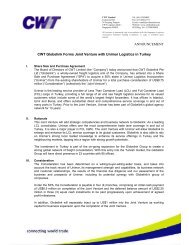notes to the financial statements - Investor Relations
notes to the financial statements - Investor Relations
notes to the financial statements - Investor Relations
You also want an ePaper? Increase the reach of your titles
YUMPU automatically turns print PDFs into web optimized ePapers that Google loves.
NOTES TO THE FINANCIAL STATEMENTS<br />
YEAR ENDED 31 DECEMBER 2011<br />
3 SIGNIFICANT ACCOUNTING POLICIES (CONT’D)<br />
3.10 Impairment of <strong>financial</strong> assets (including receivables)<br />
Annual Report 2011<br />
A <strong>financial</strong> asset not carried at fair value through profit or loss is assessed at each reporting date <strong>to</strong> determine whe<strong>the</strong>r <strong>the</strong>re<br />
is objective evidence that it is impaired. A <strong>financial</strong> asset is impaired if objective evidence indicates that a loss event has<br />
occurred after <strong>the</strong> initial recognition of <strong>the</strong> asset, and that <strong>the</strong> loss event had a negative effect on <strong>the</strong> estimated future cash<br />
flows of that asset that can be estimated reliably.<br />
Objective evidence that <strong>financial</strong> assets (including equity securities) are impaired can include default or delinquency by a<br />
deb<strong>to</strong>r, restructuring of an amount due <strong>to</strong> <strong>the</strong> Group on terms that <strong>the</strong> Group would not consider o<strong>the</strong>rwise, indications that a<br />
deb<strong>to</strong>r or issuer will enter bankruptcy, adverse changes in <strong>the</strong> payment status of borrowers or issuers in <strong>the</strong> Group, economic<br />
conditions that correlate with defaults or <strong>the</strong> disappearance of an active market for a security. In addition, for an investment<br />
in an equity security, a significant or prolonged decline in its fair value below its cost is objective evidence of impairment.<br />
The Group considers evidence of impairment for receivables at both a specific asset and collective level. All individually<br />
significant receivables are assessed for specific impairment. All individually significant receivables found not <strong>to</strong> be specifically<br />
impaired are <strong>the</strong>n collectively assessed for any impairment that has been incurred but not yet identified. Receivables that<br />
are not individually significant are collectively assessed for impairment by grouping <strong>to</strong>ge<strong>the</strong>r receivables with similar risk<br />
characteristics.<br />
In assessing collective impairment, <strong>the</strong> Group uses his<strong>to</strong>rical trends of <strong>the</strong> probability of default, timing of recoveries and <strong>the</strong><br />
amount of loss incurred, adjusted for management’s judgement as <strong>to</strong> whe<strong>the</strong>r current economic and credit conditions are<br />
such that <strong>the</strong> actual losses are likely <strong>to</strong> be greater or less than suggested by his<strong>to</strong>rical trends.<br />
An impairment loss in respect of a <strong>financial</strong> asset measured at amortised cost is calculated as <strong>the</strong> difference between its<br />
carrying amount and <strong>the</strong> present value of <strong>the</strong> estimated future cash flows discounted at <strong>the</strong> asset’s original effective interest<br />
rate. Losses are recognised in profit or loss and reflected in an allowance account against receivables. Interest on <strong>the</strong><br />
impaired asset continues <strong>to</strong> be recognised through <strong>the</strong> unwinding of <strong>the</strong> discount. When a subsequent event causes <strong>the</strong><br />
amount of impairment loss <strong>to</strong> decrease, <strong>the</strong> decrease in impairment loss is reversed through profit or loss.<br />
Impairment losses on available-for-sale investment securities are recognised by transferring <strong>the</strong> cumulative loss that has<br />
been recognised in o<strong>the</strong>r comprehensive income, and presented in <strong>the</strong> fair value reserve in equity, <strong>to</strong> profit or loss. The<br />
cumulative loss that is removed from o<strong>the</strong>r comprehensive income and recognised in profit or loss is <strong>the</strong> difference between<br />
<strong>the</strong> acquisition cost, net of any principal repayment and amortisation, and <strong>the</strong> current fair value, less any impairment loss<br />
previously recognised in profit or loss. Changes in impairment attributable <strong>to</strong> time value are reflected as a component of<br />
interest income.<br />
If, in a subsequent period, <strong>the</strong> fair value of an impaired available-for-sale debt security increases and <strong>the</strong> increase can be<br />
related objectively <strong>to</strong> an event occurring after <strong>the</strong> impairment loss was recognised in profit or loss, <strong>the</strong>n <strong>the</strong> impairment loss<br />
is reversed, with <strong>the</strong> amount of <strong>the</strong> reversal recognised in profit or loss. However, any subsequent recovery in <strong>the</strong> fair value<br />
of an impaired available-for-sale equity security is recognised in o<strong>the</strong>r comprehensive income.<br />
Share capital<br />
Ordinary shares<br />
Ordinary shares are classified as equity.<br />
Incremental costs directly attributable <strong>to</strong> <strong>the</strong> issue of ordinary shares are recognised as a deduction from equity, net of any<br />
tax effects.<br />
69





